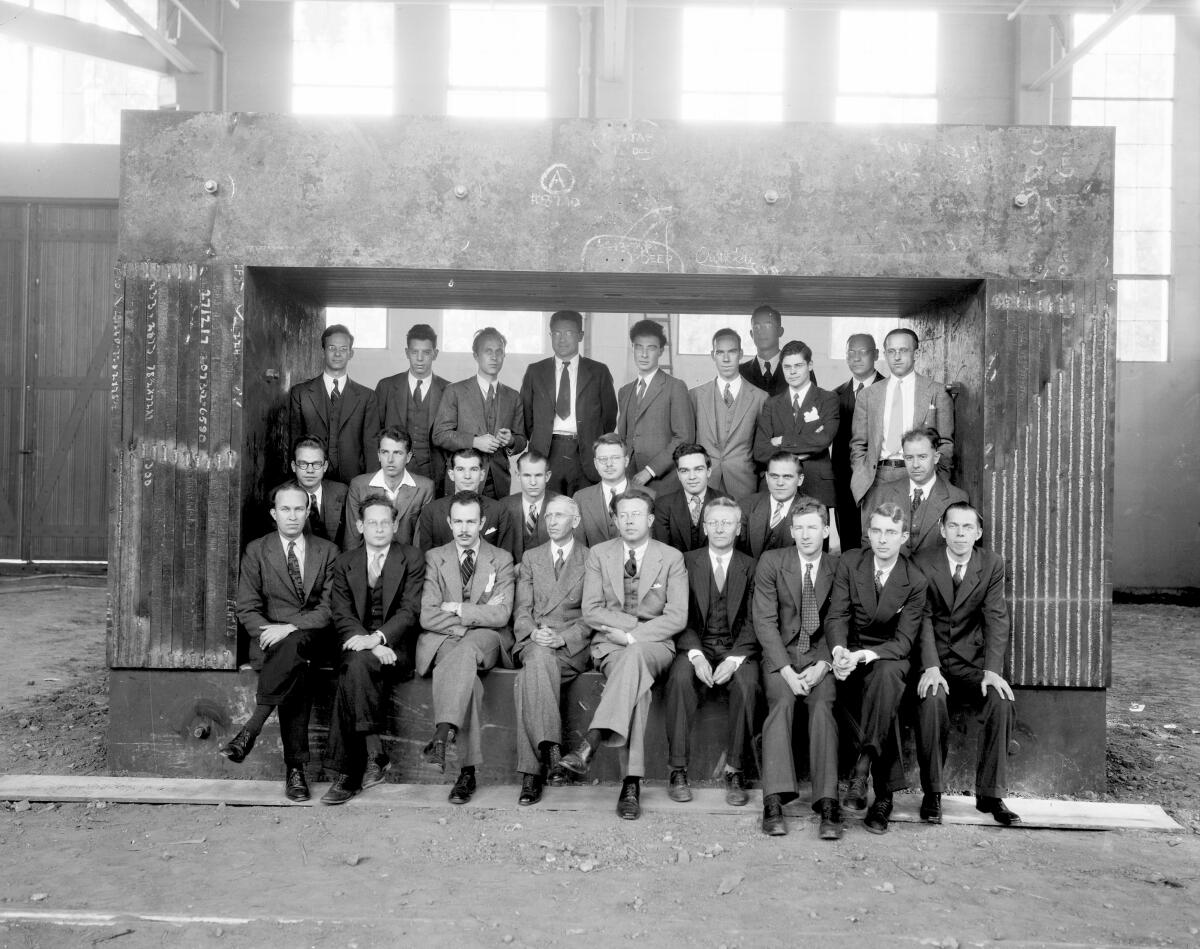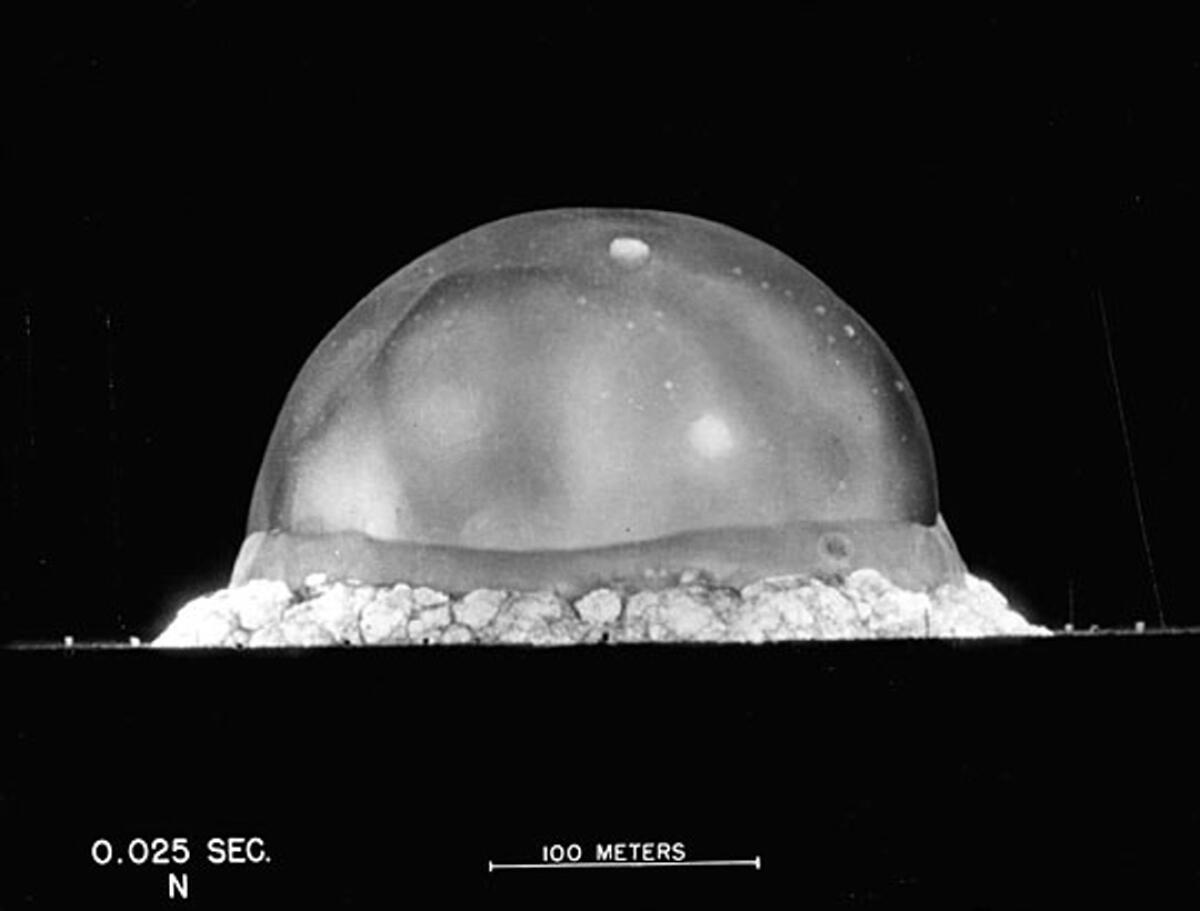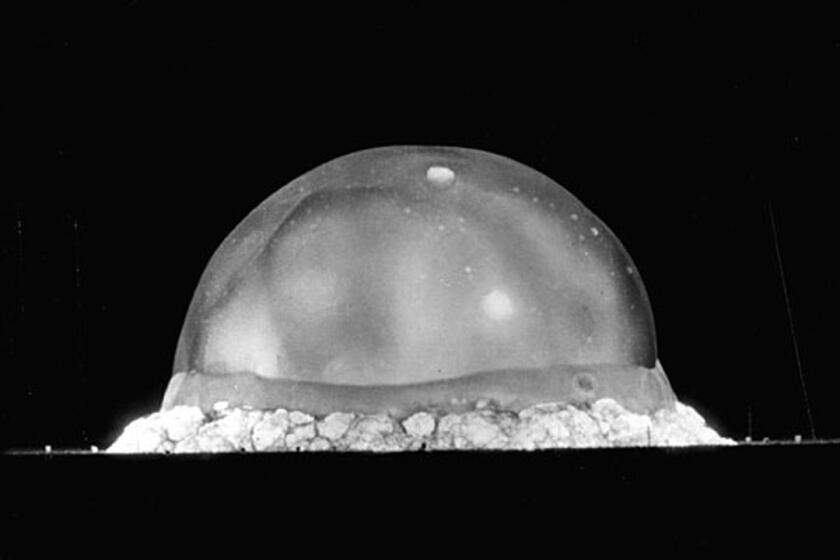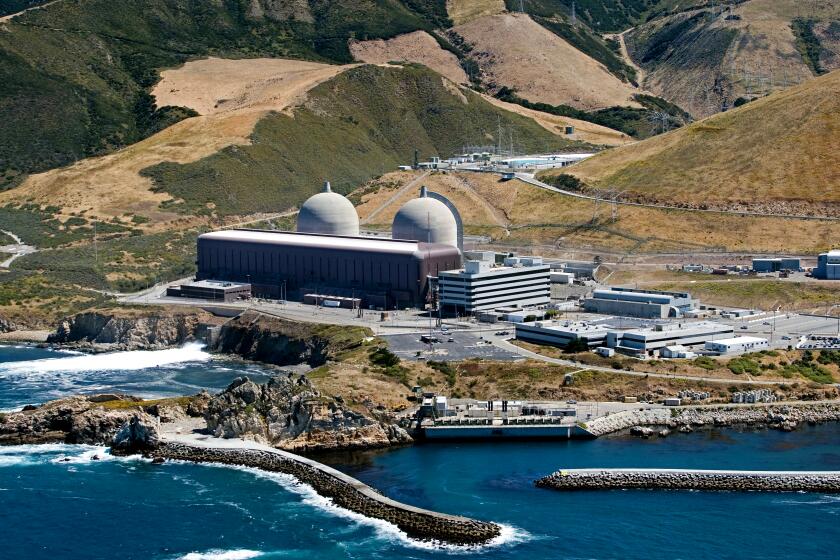‘Oppenheimer’ is a great movie, but it commits these historical blunders

- Share via
“Oppenheimer” has been justly praised for its attempt at historical fidelity in telling the life story of the brilliant, agonized physicist, but it’s not a documentary.
The movie gets most things right about Oppenheimer’s role in the Manhattan Project, the government effort to build the atomic bomb, as one would expect given that filmmaker Christopher Nolan based it on “American Prometheus,” the superb 2005 biography of J. Robert Oppenheimer by Kai Bird and Martin J. Sherwin.
But artistic imperatives and Nolan’s understandable choice to tell his story from Oppenheimer’s point of view led him to perpetuate a few myths about the making of the atomic bomb and to gloss over aspects of the story that may be interesting for lay viewers.
Oppie, is it a secret?
— Physicist Paul Ehrenfest, trying to decipher Oppenheimer’s unintelligible mumbling at a Caltech lecture
Based on what I gleaned about Oppenheimer and the project from researching my 2015 biography of Berkeley physicist Ernest O. Lawrence (played in the movie by Josh Hartnett), “Big Science,” I’ll try to correct the Hollywood record and fill in the gaps.
Let’s jump in.
Get the latest from Michael Hiltzik
Commentary on economics and more from a Pulitzer Prize winner.
You may occasionally receive promotional content from the Los Angeles Times.
For the most part, Nolan sticks to the facts. “Oppenheimer” is notable among biopics for portraying real people doing the things they did at the time. Even peripheral characters who flit briefly across the screen are given their real names or identifiable characteristics.
As far as I can tell, the only imaginary or composite character in the film is the unnamed Senate aide played by Alden Ehrenreich, whose dramatic function is to be a sounding board for the grousing of Lewis L. Strauss (brilliantly played by Robert Downey Jr.), Oppenheimer’s political nemesis.
That bongo-playing physicist glimpsed at the Trinity plutonium bomb test in the New Mexico desert? Unnamed in the film, he’s Richard Feynman, later to be revered as Caltech’s resident genius but, at 24, attached to the Los Alamos bomb lab at the very beginning of his scientific career. (He did bring his bongos to the desert.)
Lawrence’s associate Luis Alvarez, later a Nobel laureate, is accurately portrayed as bursting into an Oppenheimer seminar in 1939 with the first news of the discovery of nuclear fission by German physicists Otto Hahn and Fritz Strassmann. The film also accurately shows Oppenheimer instantly responding, “That’s impossible,” promptly withdrawing his snap judgment and, within a week, outlining how the discovery might be used to make a bomb.
75 years ago today, an a-bomb test in the New Mexico desert launched the nuclear age
But the film doesn’t cover Alvarez’s resentful and damaging testimony in the Oppenheimer security hearing, during which he claimed to have heard Vannevar Bush, the top science advisor to Presidents Franklin Roosevelt and Harry Truman, reveal that Truman had not trusted Oppenheimer. Bush — who is played by Matthew Modine — vociferously contradicted the story.
The most glaring historical gaffe is the film’s perpetuation of the myth that Oppenheimer was the boss of the Manhattan Project; it shows him assuring Gen. Leslie R. Groves that he can run the project. (Matt Damon would have had to put on at least 50 or 60 pounds to more accurately impersonate Groves, who tipped the scales at nearly 300 pounds.)
Oppenheimer was merely the boss of Los Alamos, one of the project’s numerous separate labs and technical installations. Its job was to actually build the bomb, drawing on the research of labs at Columbia, the University of Chicago and Berkeley. Though Groves was the overall boss, the project’s scientific management was divided, rather tetchily, between Lawrence and Arthur Holly Compton of the University of Chicago.
Lawrence was the scientist whose advice Groves trusted the most. He originally wanted Lawrence to run the lab that was eventually built at Los Alamos, but decided Lawrence was too important to be limited to the bomb-designing task.
Oppenheimer was Groves’ second choice, but he turned to Lawrence for assurance that Oppenheimer could effectively run the bomb lab.
Lawrence, who at that time was a close friend of Oppenheimer, his valued colleague at UC Berkeley — he named his first son Robert after Oppenheimer — assuaged Groves’ concerns about Oppenheimer’s leftist politics and lack of a Nobel Prize. Lawrence sealed the deal for his friend by promising Groves that if Oppenheimer failed in his task, he would take it over himself.
A few words about Ernest Lawrence. Before and during the war, the South Dakota native was the most famous and influential scientist in America — arguably the first home-grown scientific celebrity in American history.

The inventor of the cyclotron, the most important atom-smasher of its era and the invention that transformed particle physics in the 1930s, Lawrence was featured on the cover of Time magazine on Nov. 1, 1937, over the caption “He creates and destroys,” and won the Nobel Prize in 1939.
Lawrence’s skill at explaining complex scientific principles in lay terms kept him in the public eye via radio talks and newspaper articles and helped him attract millions of dollars in foundation and government funding for his Radiation Laboratory — the “Rad Lab” — at UC Berkeley. It was due to his influence that UC was awarded the contract to run Los Alamos after the war, which it still holds, albeit with somewhat diminished authority. Lawrence also invented a color TV system that was eventually incorporated into Sony’s Trinitron technology.
Oppenheimer, by contrast, was almost entirely unknown to the general public until after the bombs were dropped on Hiroshima and Nagasaki in August 1945, when he was thrust into fame as “the father of the atomic bomb.”
Among the physics fraternity, however, Oppenheimer was virtually a cult figure, which is painted only murkily in the film. His graduate students at Berkeley and Caltech, where he held joint appointments, chain-smoked his brand of cigarettes (Chesterfields), imitated his loping gait, and replicated the almost unintelligible mumbling of his lecturing style.
Austrian physicist Paul Ehrenfest, a friend of Oppenheimer’s who sat through one of his Caltech lectures straining to make out his words, finally blurted out, “Oppie, is it a secret?”
Hiltzik: Keeping the Diablo Canyon nuclear plant open is a dangerous waste of effort and money
Gov. Newsom says Diablo Canyon needs to keep operating to meet California’s renewable energy goals. That’s wrong and dangerous.
Another myth perpetuated by the film is that the physicists were afraid that the bomb blast might ignite the atmosphere, destroying the world. “Oppenheimer” depicts this possibility being debated almost as late as the Trinity test. In fact, it had been raised very briefly in 1942 and promptly put to rest by Manhattan Project physicist Hans Bethe, who later called it “absolute nonsense.”
One more point concerns Oppenheimer’s recollection that upon witnessing the fireball produced by the Trinity test, he immediately thought of a line from the Sanskrit Bhagavad-Gita: “I am become death, destroyer of worlds.”
The film takes him at his word, but the truth is that he never mentioned this in public until 1965; one friend considered the claim to be one of Oppenheimer’s “priestly exaggerations.” By the way, the line from the Hindu scripture has been translated in other ways, notably as “I am become time, destroyer of worlds,” perhaps a subtler and more sinister thought than Oppie’s version.
Some aspects of the 1954 security hearing as depicted in the film warrant further examination. The film accurately shows that Groves, asked if he would give Oppenheimer a security clearance at the time of the hearing, answered carefully that he would not, under the stringent security rules imposed by the Atomic Energy Commission. But his subsequent sotto voce remark, to the effect that he probably wouldn’t give any of the Manhattan Project scientists clearance under those rules, doesn’t appear anywhere in the 1,011-page hearing transcript.
For the record:
12:45 p.m. Aug. 2, 2023A previous version of this column said Caltech physicist Richard Tolman died by suicide. He died of a heart attack.
Then there’s Lawrence’s decision not to testify against his old friend. By 1954, Lawrence and Oppenheimer had had a bitter falling-out. The film attributes this mostly to Lawrence’s fury upon learning that Oppenheimer had carried on an affair with the wife of Caltech physicist Richard Tolman, a close friend of Lawrence. Tolman died of a heart attack shortly after learning of the betrayal, which Lawrence ascribed to his broken heart.
But another reason for their split was Oppie’s campaigning against the hydrogen bomb program, which Lawrence favored and which was a major source of government patronage for his lab — Lawrence Livermore National Laboratory, an offshoot of the Rad Lab, had been founded largely to pursue research on the so-called Super.

Although Lawrence had promised Strauss, who as chairman of the AEC oversaw all civilian government nuclear research and stage-managed the security hearing, that he would testify, he was racked with second thoughts as his appearance date approached.
Lawrence knew that the physics community overwhelmingly supported Oppenheimer, and that Berkeley had become the center of anti-Oppenheimer sentiment, in part because of the conflict over the H-bomb program. This was not a good look for the Rad Lab.
Contrary to the film’s depiction, Lawrence never actually showed up outside the hearing room. Instead, he phoned Strauss the Monday before his scheduled appearance from the government’s Oak Ridge lab, which he had founded and designed for the production of enriched uranium for the bomb ultimately dropped on Hiroshima (the Trinity test was of a plutonium bomb like that dropped on Nagasaki, which was a much more complicated engineering challenge).
As the film shows, Lawrence pleaded a medical excuse — an outbreak of ulcerative colitis, the condition that would ultimately kill him in 1958. After Strauss responded with a vicious tongue-lashing over the phone, culminating in an accusation of cowardice, Lawrence summoned his fellow Oak Ridge guests, all government lab directors, to prove he was not feigning illness by showing them his toilet, brimming with bright red blood.
Christopher Nolan’s film implicitly asks viewers to come to their own conclusions about the moral dimension of the decision to drop the bomb on Japan. A committee of four physicists — Oppenheimer, Lawrence, Compton and Enrico Fermi — was tasked with the options, which included staging a demonstration at an uninhabited Pacific island to show Japanese officials what they faced if they didn’t surrender.
Lawrence, who had worked with Japanese scientists to build the first cyclotrons outside the U.S., was the last member of the committee to agree that using the bomb was the only choice, for the possibility of a dud demonstration was too great to risk. As the committee chair, Oppenheimer signed the one-page memo, dated June 16, 1945, that came to the dismaying conclusion that “we see no acceptable alternative to direct military use.”
What the physicists didn’t know was that the decision already had been taken out of their hands. That Boeing B-29 bombers that would carry the bombs had already been assembled on Tinian Island, 1,500 miles south of Japan, and the military decision to use the bombs was preordained.
How should we think about the development of nuclear weapons and Oppenheimer’s role? My view is that the Manhattan Project was understandable and defensible given the wartime context. Allied physicists, especially refugees from the Nazi regime, knew that although Hitler had driven away Jewish scientists, the physicists left behind in Germany were among the best in the world, perfectly capable of developing the atomic bomb. They were in a panic that Hitler might get the weapon before the Allies.
They had no way of knowing that, as the Allies discovered after Germany’s surrender, there had been no German bomb project because the Germans miscalculated the physics involved and didn’t have access to the resources and equipment, including the cyclotron, in the U.S. and Britain.
The decision to pursue the hydrogen bomb is another story. Fermi and other leading physicists understood that its incredible power meant it could only be a weapon of genocide. Some worked on it anyway. Oppenheimer’s notion that nuclear research should be placed under international control to forestall the perils of nuclear proliferation was idealistic, but in terms of geopolitical reality hopelessly naive. There was no way that the U.S. and Britain would cede control of the technology to any international body after 1945.
The tragic message of Oppenheimer and “Oppenheimer” is that humankind has lived under a nuclear sword of Damocles ever since.
More to Read
Get the latest from Michael Hiltzik
Commentary on economics and more from a Pulitzer Prize winner.
You may occasionally receive promotional content from the Los Angeles Times.













